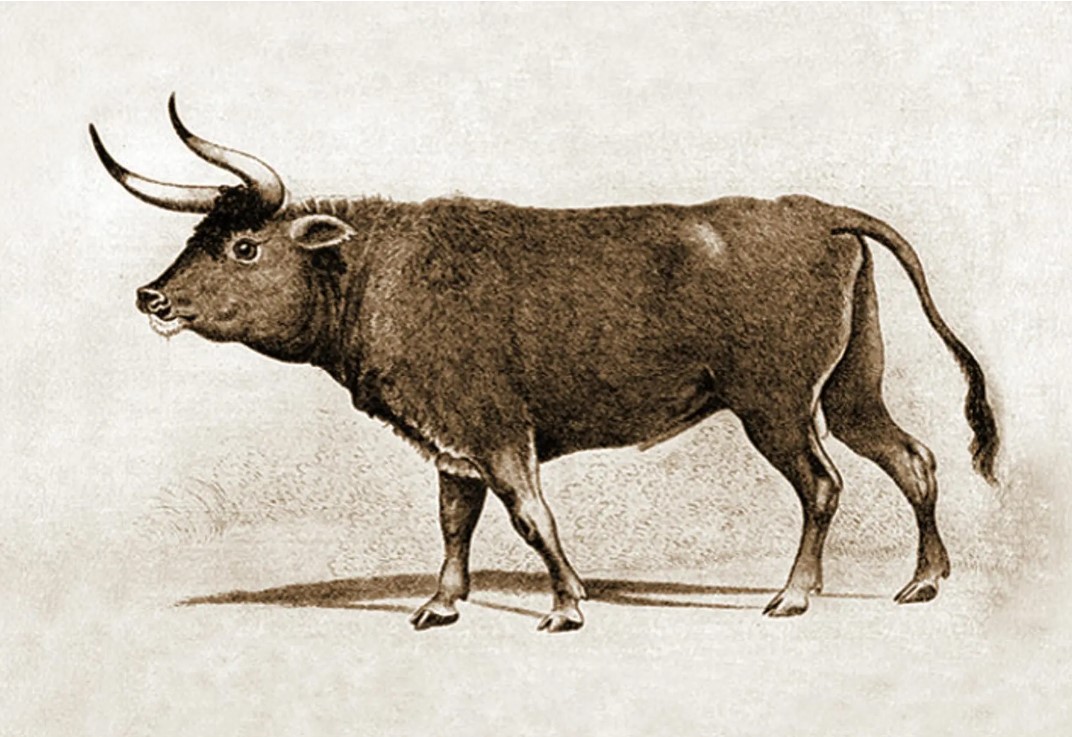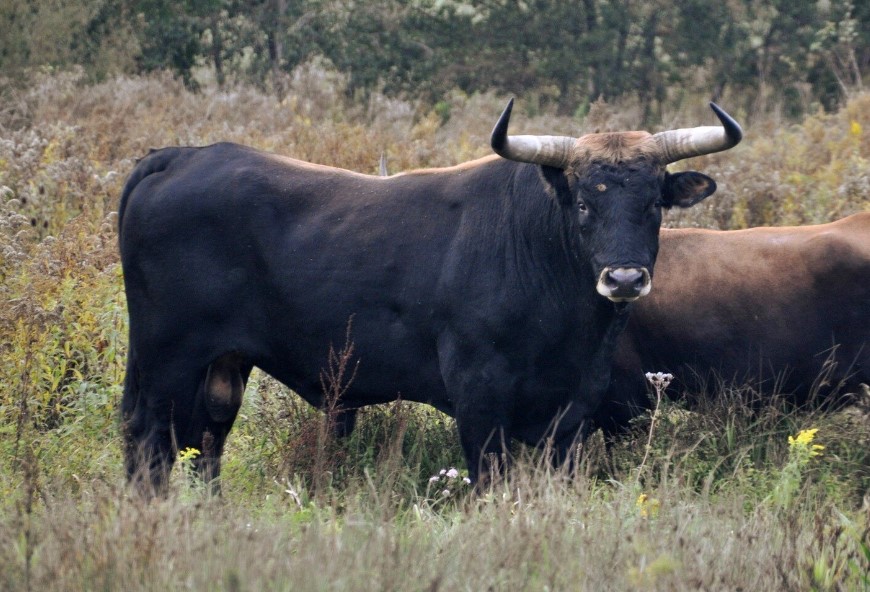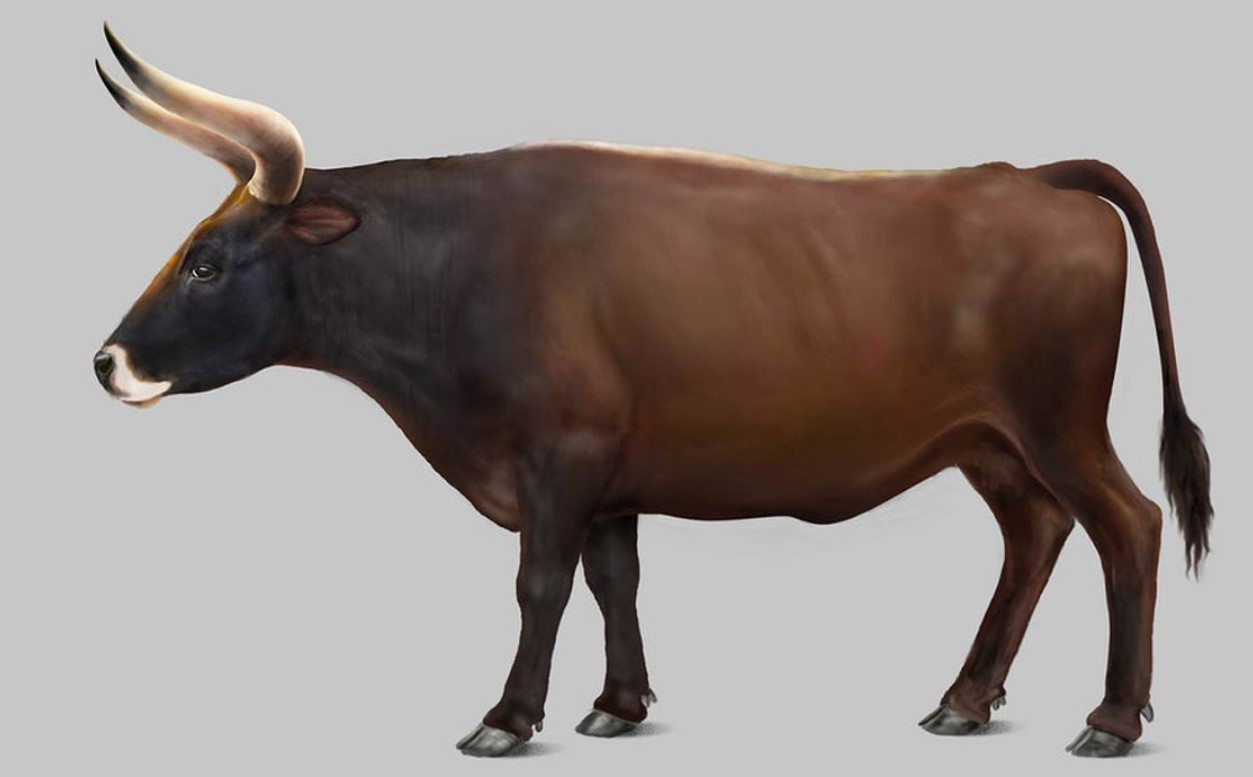





The Aurochs is an extinct species of cattle that is considered to be the wild ancestor of the domestic cattle. It was part of the Pleistocene megafauna along with woolly mammoths, mastodons, woolly rhinos, American lions, saber-toothed tigers, and short-faced bears. They were mostly depicted in cave paintings. The different species of aurochs went extinct through habitat loss, interbreeding with domestic cattle, and excessive hunting. The last one died in 1967 from natural causes.
People didn’t know about this animal’s coat colour until the early 1980s. Depictions show that the North African aurochs may have had a light saddle marking on its back. Calves were probably born with a chestnut colour, and young bulls changed to black with a white stripe running down the spine, while cows retained a reddish-brown colour. Both sexes had a light-coloured muzzle, but evidence for variation in coat colour does not exist. Egyptian grave paintings showed them with reddish-brown coat colour in both sexes, with a light saddle, but the horn shape of these suggests that they may depict domesticated cattle. Aurochs are sexually dimorphic, with males being bigger than the females and also having black fur, a light eel stripe, and a pale mouth while the females were smaller and were brown. Their bodies were characterized by a robust build, long legs, and a pair of large, sweeping horns that curved outward and upward. The size of this animal varied by region with specimens being larger in Europe than farther south. Aurochs in Denmark and Germany ranged in height at the shoulders between 155–180 cm in bulls and 135–155 cm in cows, while aurochs in Hungary reached 160 cm.
The aurochs is considered by people to be the wild ancestor of all domestic cattle on Earth. They didn’t have any natural predators as adults, but as claves, they were vulnerable to predators like gray wolves, and brown bears. Lions, tigers, and hyenas were their predators during prehistoric times. According to historical descriptions, the aurochs was swift despite their build and could be very aggressive if provoked, but was not generally fearful of humans. The shape of its jaw meant that this animal was a grazer and mostly ate grass, twigs, and acorns. Aurochs formed small herds in the winter but they typically lived singly or in smaller groups during the summer. Mating season happened in September and calves were born in the spring. The bulls had violent fights during the rutting season. In autumn, aurochs fed for the winter, gaining weight and possessing a shinier coat than during the rest of the year. Calves stayed with their mothers until they were strong enough to join and keep up with the herd on the feeding grounds. People domesticated these cattle, with the earliest known domestication dating to the Neolithic Revolution when cattle hunted and kept by Neolithic farmers gradually decreased in size between 9800 and 7500 BC. This eventually led to the rise of different breeds of domestic cattle.
Aurochs in different regions of the world went extinct in many ways. The Indian Aurochs went extinct due to habitat loss, which was caused by expanding farms and also interbreeding with domesticated zebu. The African Aurochs might have survived until the Roman Empire according to the fossils found in the Nile Delta. The Eurasian Aurochs was excessively hunted until it was nearly extinct. By the 13th century, the aurochs existed only in small numbers in Eastern Europe, and hunting became a privilege for nobles and later, royals. The population in Hungary declined since at least the 9th century and was extinct in the 13th century. The last known aurochs herd lived in a marshy woodland in the Jaktorów Forest in Poland. It decreased from around 50 individuals in the mid-16th century to four individuals by 1601. The last aurochs cow died in 1627 from natural causes.
In the early 1920s, Heinz Heck, director of the Hellabrunn Zoo in Munich, Germany, initiated an artificial selective breeding program for breeding back the aurochs using several breeds of domestic cattle. This eventually led to the Heck cattle who were then released into the grassy fields to restore the prehistoric landscapes. Sadly, large numbers of them died of starvation during the cold winters of 2005 and 2010, and the project of no interference ended in 2018. In 1996, Heck cattle were then crossed with southern European cattle breeds like Sayaguesa, Chianina, and to a lesser extent, Spanish Fighting Bulls to create a breed of cattle that looked like the extinct species. Another breeding-back project is the Tauros Programme.